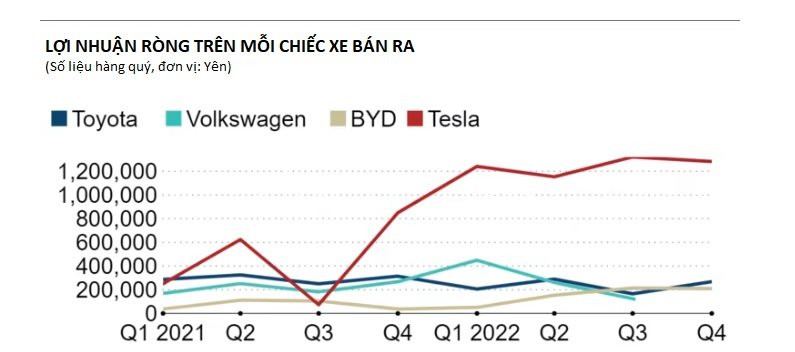No one like Toyota: Each car sold is only one-fifth as profitable as Tesla because of up to 80% of the extra costs for suppliers, less than even a Chinese EV startup.
- Tram Ho
The Nikkei reported that Toyota Motor made five times less profit per car than Tesla during the April-December 2021 period as the Japanese auto giant struggled with rising costs.
Specifically, Toyota made 240,000 yen ($1,820) in net profit per vehicle sold during the aforementioned period last year. In contrast, Tesla made the equivalent of 1.26 million yen per car over the same period.
This difference shows the limits of Toyota’s “multi-solution” strategy when it comes to eliminating gasoline cars alongside fuel cell and electric vehicles. The wide-ranging approach has exposed Toyota to a more expensive business environment, while Tesla has managed to avoid it thanks to its EV-focused product line.

In the nine months ending December 2022, Toyota’s material costs rose 1.1 trillion yen from a year earlier. Toyota is expected to save 210 billion yen in group-wide costs for the financial year ending March, but that won’t be enough to cover the costs incurred.
This trend is particularly evident in Toyota’s North American operations, where it is often easier to solve the problem of higher costs by raising list prices than it is in Japan.
In the three quarters through December, Toyota made 49.2 billion yen in operating profit in North America, down about 450 billion yen from the same period last year. The company suffered an operating loss in that region during the October-December quarter.
“Rising prices have not kept pace with rising material costs,” said a Toyota executive.
In Japan, an executive at a parts supplier in Aichi Prefecture who works with Toyota expressed relief despite facing rising fuel costs.
“It looks like Toyota will pay 70%-80% of that,” the executive said.
Toyota has partially covered increased energy bills and raw materials costs for its suppliers since last summer. Parts supplier in Aichi has successfully negotiated an agreement with Toyota under which the automaker will bear most of the extra fuel costs.
“There is no other automaker that cares about electricity and gas bills like Toyota,” said a senior manager at another parts supplier.
Globally, Toyota alone has business relationships with about 400 suppliers. Covering the cost of fuel and materials for that number of suppliers is obviously a costly endeavor.
Toyota seeks to maintain its supply chain so that it can save costs along with its suppliers, although much of the scale comes from Toyota. The world’s best-selling automaker has adopted a strategy of expanding about 50 models from gasoline to electric vehicles.
Because of that business model, higher costs have begun to weigh on Toyota. The company’s profit per vehicle from April to December fell 56,000 yen from a year earlier, while Tesla increased the equivalent of 500,000 yen.
Unlike Toyota’s diverse lineup, Tesla only offers four premium models. Since 2021, Tesla has significantly expanded its production and sales capacity, which has improved the company’s monetization.
In the three quarters through December, Tesla made a net profit of 1.26 trillion yen, roughly equal to the 1.9 trillion yen Toyota made in the same period.
BYD, China’s mass-market electric vehicle maker, is making between 190,000 and 200,000 yen per vehicle, also higher than Toyota. Last year, BYD sold 1.86 million electric vehicles, including plug-in hybrids, a 3.1-fold increase.
This momentum comes from BYD’s vertical integration. The company makes its own car batteries and controls a semiconductor manufacturing subsidiary.
BYD is rapidly expanding its operations worldwide, the latest move being to start selling electric vehicles in Japan this January. Along with Tesla, BYD is gradually asserting its name thanks to its strong monetization ability.
In order for Toyota to cope with its competitors, the company faces the immediate challenge of increasing production. Toyota plans to sell up to 10.6 million units this year under the Toyota and Lexus brands.
If Toyota hits its production goals, it will be able to use economies of scale to reduce costs while not missing out on sales opportunities. Increasing car prices will probably become easier under this scenario.
However, increasing production has always been “easier said than done”. On Thursday, Toyota said it plans to produce only 9.1 million units this financial year, down 100,000 units due to a shortage of semiconductors.
Toyota seeks to respond by minimizing the amount of semiconductors used in each vehicle. In addition, the Aisin company of the Toyota group is redesigning the gearbox and other components manufactured by this company. Aisin is adopting designs that can accommodate existing semiconductors.
This spring, Lexus will add the all-electric RZ to its lineup. Koji Sato, the incoming president of Toyota, oversaw the development of the model. Toyota plans to expand its EV lineup, an approach that has been delayed by the company’s multi-solution strategy.
Source: Nikkei
Source : Genk
